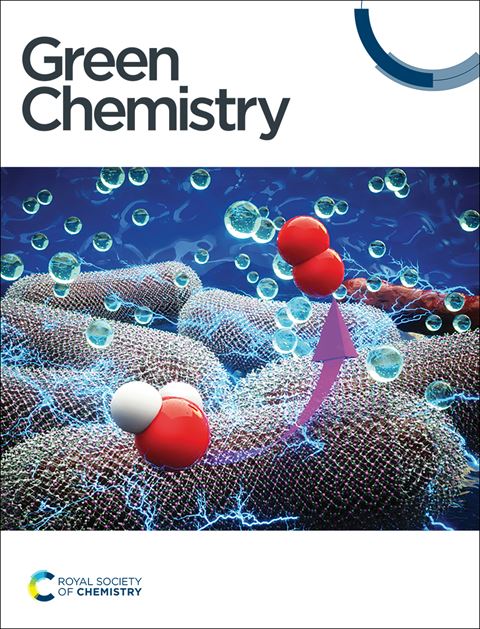使用定制溅射CuAg电极提高电化学CO2还原的选择性和稳定性
IF 9.3
1区 化学
Q1 CHEMISTRY, MULTIDISCIPLINARY
引用次数: 0
摘要
铜上的电化学二氧化碳还原(eCO2RR)提供了一种很有前途的方法,将捕获的二氧化碳转化为有价值的化学物质(C2+),如乙烯和乙醇。本研究考察了Cu和Ag作为共催化剂通过磁控溅射沉积在气体扩散电极(GDEs)上以提高C2+选择性,并评估了不同的配置:cuag层状(L)、agcu层状(L)、cuagcu层状(L)和cuag共沉积(CD)。在电流密度为150 mA cm - 2时,400 nm的Cu层具有最高的C2+选择性(73%),优于50 nm和800 nm层(61%和62%)。其中Cu99Ag1-CD对C2+的选择性最高(75%),对乙烯和乙醇的选择性分别达到42%和24%。层状结构表现出较低的选择性,因为CO从Ag溢出到Cu,减少了C-C耦合。共沉积的CuAg合金增强了CO的转移,同时稍微有利于含氧化合物而不是碳氢化合物。在150 mA cm−2下的电极稳定性测量表明,表面重建和电极泛洪触发了析氢。为了减轻这种脉冲eCO2RR,成功地应用了间歇氧化脉冲。制备的双金属Cu99Ag1-CD在150 mA cm−2下达到75%的最大总FEC2+,这是这些催化剂中文献报道的最高的。本文章由计算机程序翻译,如有差异,请以英文原文为准。
Enhancing selectivity and stability in electrochemical CO2 reduction using tailored sputtered CuAg electrodes†
Electrochemical CO2 reduction (eCO2RR) over copper offers a promising method to convert captured CO2 to valuable chemicals (C2+), such as ethylene and ethanol. This study examines Cu and Ag as co-catalysts deposited on gas diffusion electrodes (GDEs) via magnetron sputtering to improve C2+ selectivity, and evaluates different configurations: CuAg-layered (L), AgCu-layered (L), CuAgCu-layered (L), and CuAg-co-deposited (CD). A 400 nm Cu layer achieved the highest C2+ selectivity (73%), outperforming 50 nm and 800 nm layers (61% and 62%), at a current density of 150 mA cm−2. Among CuAg compositions, Cu99Ag1-CD exhibited the highest C2+ selectivity (75%), with ethylene and ethanol selectivities reaching 42% and 24%, respectively. Layered configurations showed lower selectivity due to limited CO spill-over from Ag to Cu, reducing C–C coupling. Co-deposited CuAg alloys enhanced CO transfer, whilst slightly favouring oxygenates over hydrocarbons. Electrode stability measurements at 150 mA cm−2 revealed that surface reconstruction and electrode flooding trigger hydrogen evolution. To mitigate this pulsed eCO2RR, intermittent oxidative pulses were successfully applied. The as-prepared bimetallic Cu99Ag1-CD achieved a maximum total FEC2+ of 75% at 150 mA cm−2, which is amongst the highest reported in the literature for these catalysts.
求助全文
通过发布文献求助,成功后即可免费获取论文全文。
去求助
来源期刊

Green Chemistry
化学-化学综合
CiteScore
16.10
自引率
7.10%
发文量
677
审稿时长
1.4 months
期刊介绍:
Green Chemistry is a journal that provides a unique forum for the publication of innovative research on the development of alternative green and sustainable technologies. The scope of Green Chemistry is based on the definition proposed by Anastas and Warner (Green Chemistry: Theory and Practice, P T Anastas and J C Warner, Oxford University Press, Oxford, 1998), which defines green chemistry as the utilisation of a set of principles that reduces or eliminates the use or generation of hazardous substances in the design, manufacture and application of chemical products. Green Chemistry aims to reduce the environmental impact of the chemical enterprise by developing a technology base that is inherently non-toxic to living things and the environment. The journal welcomes submissions on all aspects of research relating to this endeavor and publishes original and significant cutting-edge research that is likely to be of wide general appeal. For a work to be published, it must present a significant advance in green chemistry, including a comparison with existing methods and a demonstration of advantages over those methods.
 求助内容:
求助内容: 应助结果提醒方式:
应助结果提醒方式:


